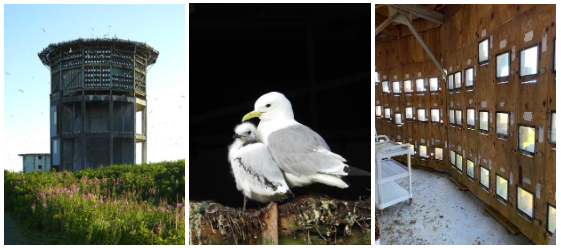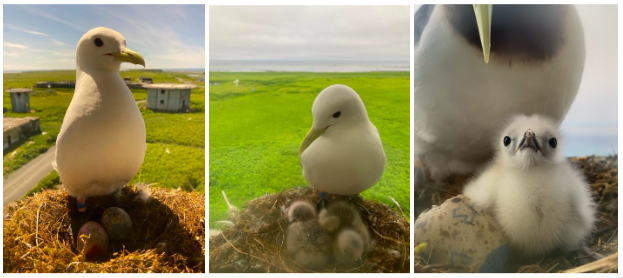by Lauren Jackson
I stepped aboard the tiny plane and watched as the door closed behind me. Minutes later the wheels left the ground, and I looked down at what was my last glimpse of civilization for the next 4 months.

Figure 1: Small charter plane on Middleton Island, Alaska.
Middleton Island is a small, uninhabited island in the Gulf of Alaska. Measuring an impressive 8 by 2 kilometers, this island is home to thousands of breeding seabirds during the summer season. Here, abandoned buildings speckle the grounds, all decrepit remnants of a Cold War era US military base. What once was a collection of impressive radar towers and housing units now lies in various stages of decomposition, with many skeletal structures littering the earth. It’s difficult to imagine what once was here, as the island has begun consuming these buildings, moss sinking its teeth into the stones, grass grappling at the remaining metals. This place looks to be untouched by humans for decades–except for the remaining radar tower.
The Tower, as it is informally named, is a decommissioned radar structure that has been refurbished to house hundreds of breeding black-legged kittiwake pairs. These small gulls are cliff nesters, but the lack of natural cliff sites on the island has driven them to seek refuge in the remaining man-made structures. Middleton Island offers the perfect opportunity to study these birds, and modifications to the Tower have made it possible for scientists to keep a close eye on their breeding cycle. The large circular building has been outfitted with hundreds of shelves, each with a private one-way mirrored window. From inside the Tower, the observer can look out at the birds nesting on the shelves, watching them closely from only inches away. Outside, the birds remain none the wiser, with only their own reflection in the glass looking back at them. This model allows for low disturbance observation and has turned Middleton Island into one of the longest running seabird monitoring sites in the world.


Figure 2 (top left): The Tower on Middleton Island, Alaska
Figure 3 (top center): A black-legged kittiwake chick stands in the nest with its parent.
Figure 4 (top right): Inside the Tower, with a view of many nesting sites with 1-way windows.
Figure 5 (bottom): A panoramic shot of the top floor inside the Tower.
Aside from annual seabird monitoring activities, Middleton hosts a number of research scientists from various institutions year after year. Enter me: an undergraduate student from McGill pursuing a research project for my honours program. I was accompanied on the island by my research partner Alex Turmaine. Together, we designed a joint research project with the black-legged kittiwakes that spanned the entirety of their breeding season from May to August.

Figure 6: Lauren Jackson and Alexandre Turmaine standing at their work station inside the Tower on Middleton Island, Alaska.
During this time, we watched as birds arrived on the island, meeting their respective partners, and settling down in their favorite spots on the tower. During the first few weeks, nests slowly started to appear on each shelf as the couples worked diligently throughout the day, carrying small bits of mud and grass for construction. Not long after, the first eggs began to appear. Nestled into the cozy baskets, small, speckled eggs were laid in pairs at nearly every window. The birds took turns incubating, each spending hours nestled down in the nest, fiercely protecting their eggs from predators and warming them against their bodies. Meanwhile, their partners spent some time at sea foraging for their next meal. After weeks of growth, small chicks began to emerge from their shells. Trembling and wet, these tiny creatures slowly broke free from their eggs, wiggling under their parent for warmth and comfort. Quickly they dried, and before long small balls of fluff waited hungrily in their nests, begging their parents for food. These little creatures grew remarkably fast, their size nearly doubling in only a few days’ time. At only 40 days old, the fully grown chicks took to the skies, stretching their wings and leaping from the tower for the first time. As more and more chicks reached maturity, the skies became filled with young kittiwakes exploring the island beyond the tower. They streaked wildly across the sky, landing shakily on various structures as they tested the limits of their new wings. The world opened up for them, and they took off to see it.

Figure 7 (left): Black-legged kittiwake adult at its nest with 2 eggs.
Figure 8 (center): Black-legged kittiwake adult at its nest with 2 newly-hatched chicks.
Figure 9 (right): Black-legged kittiwake chick inside the nest next to hatching egg, with parent standing over.
Throughout this wonderful process, Alex and I were hard at work with the birds. Nearly every early morning we trudged up the many flights of stairs into the tower, where we set up our workstation for the day. It always started like this: I unpack my blood sampling equipment, carefully lining up meters, syringes, cotton balls, and more on the bench. Next to me, Alex boots up the ultrasound machine and assembles lines of accelerometers–small biologging devices that track animal movement. We scan the list of our target birds for the day, walking quiet laps around the tower, searching for the birds we want to catch. Once we spot one, we hold our breath, and we slide a small hook through the slot below the window at the bird’s nest. The hook loops around the leg of the bird, holding it in place, and we open the window before reaching outside to bring the bird in. The birds are usually unhappy, yelling loudly at us and biting at our fingers in attempt to escape. We bring the bird to the workstation where I quickly draw a blood sample and run some blood tests. Next, I assist Alex with an ultrasound of the bird’s flight muscles before we attach a small accelerometer to its tail. When we are finished, the bird is released back outside, where it shakes off its ruffled feathers and heads back to its nest. A few days later we repeat this process, recapturing the same bird to remove the accelerometer before releasing them one last time.

Figure 10 (top left): Lauren Jackson holding a kittiwake with accelerometer attached.
Figure 11 (top center): Lauren Jackson holding a kittiwake next to its window.
Figure 12 (top right): Blood samples collected from kittiwake.
Figure 13 (bottom left): Alexandre Turmaine holds a kittiwake as Lauren Jackson collects a blood sample.
Figure 14 (bottom right): Lauren Jackson holds a kittiwake while Alexandre Turmaine performs an ultrasound.
Over many weeks of work, Alex and I performed over 300 captures, collecting huge amounts of data and information in the process. What we learn from these birds can help protect kittiwake and other seabird populations for years to come. By understanding more about the physiology, behavior, and needs of these animals, we can better inform conservation efforts and future science as well.
After long days of work, we always left the tower to head back to camp for the night. The whole crew of 8-10 people shared a small building endearingly termed “The Chateau”, which was outfitted with a living room, kitchen, and office. Every night dinner was cooked by 2 of the crew members, and the rest of us occupied ourselves with other activities while we waited hungrily for food to appear. We usually sat huddled around the fire in the wood burning stove, some of us reading books, some napping, and others playing games. When the weather was nice, we often took hikes around the island, donning our binoculars and cameras to spot birds passing through. Dinner was always served around 8pm, when we would all cluster around the kitchen table with our bowls and plates full of warm food, excited to share anecdotes from our day. With full bellies and tired eyes, we would later retire to our tents. My tent was pitched about 100 meters from the Chateau, and I often enjoyed the peaceful walk to bed in the cool evening air. Inside my tent I would wrap myself in my sleeping bag and lay quietly as I listened to the ocean crashing down on the shore nearby. I would drift off to sleep before waking again to a new day, when I would rise and walk back to the Chateau, back to the Tower, where I would do this all over again.



Figure 15: The Chateau in the evening.
Figure 16: The Tower during sunset.
Figure 17: Lauren Jackson’s tent at night.

Lauren Jackson is an undergraduate student in her 4th year at McGill University Macdonald Campus. She is studying environmental biology with a specialization in wildlife biology and is completing her honours research in Dr. Kyle Elliott’s Arctic Ecology lab. Her research interests are seabird biology, with an emphasis in reproductive physiology.

0 Comments